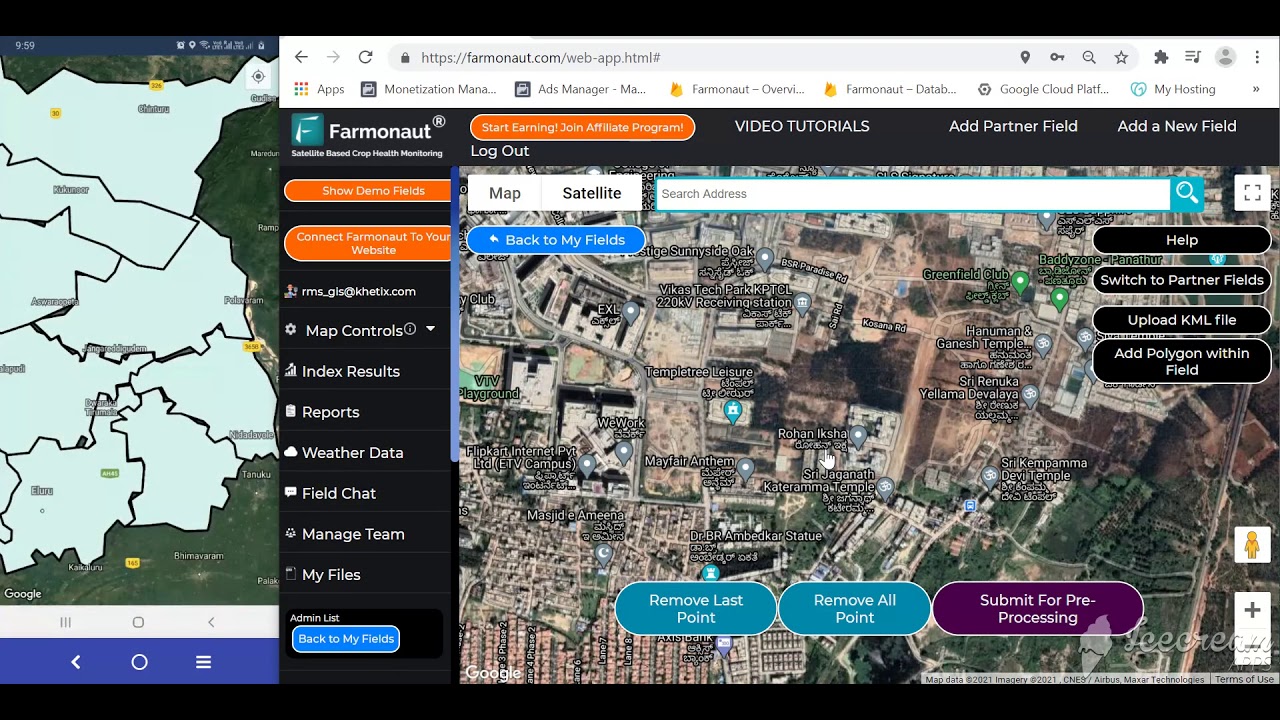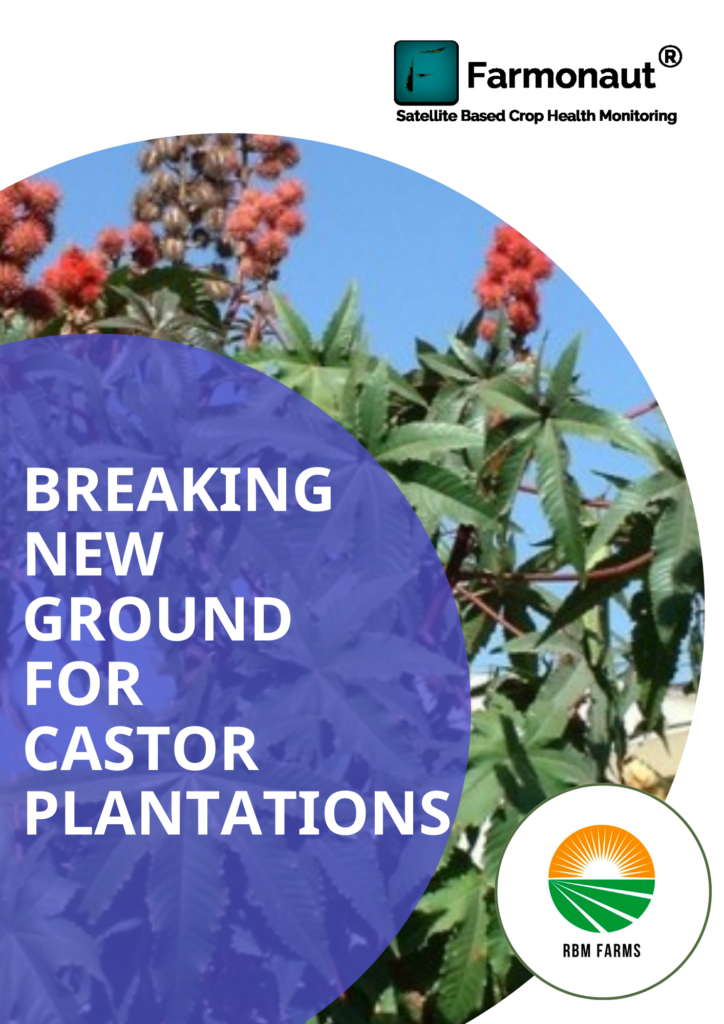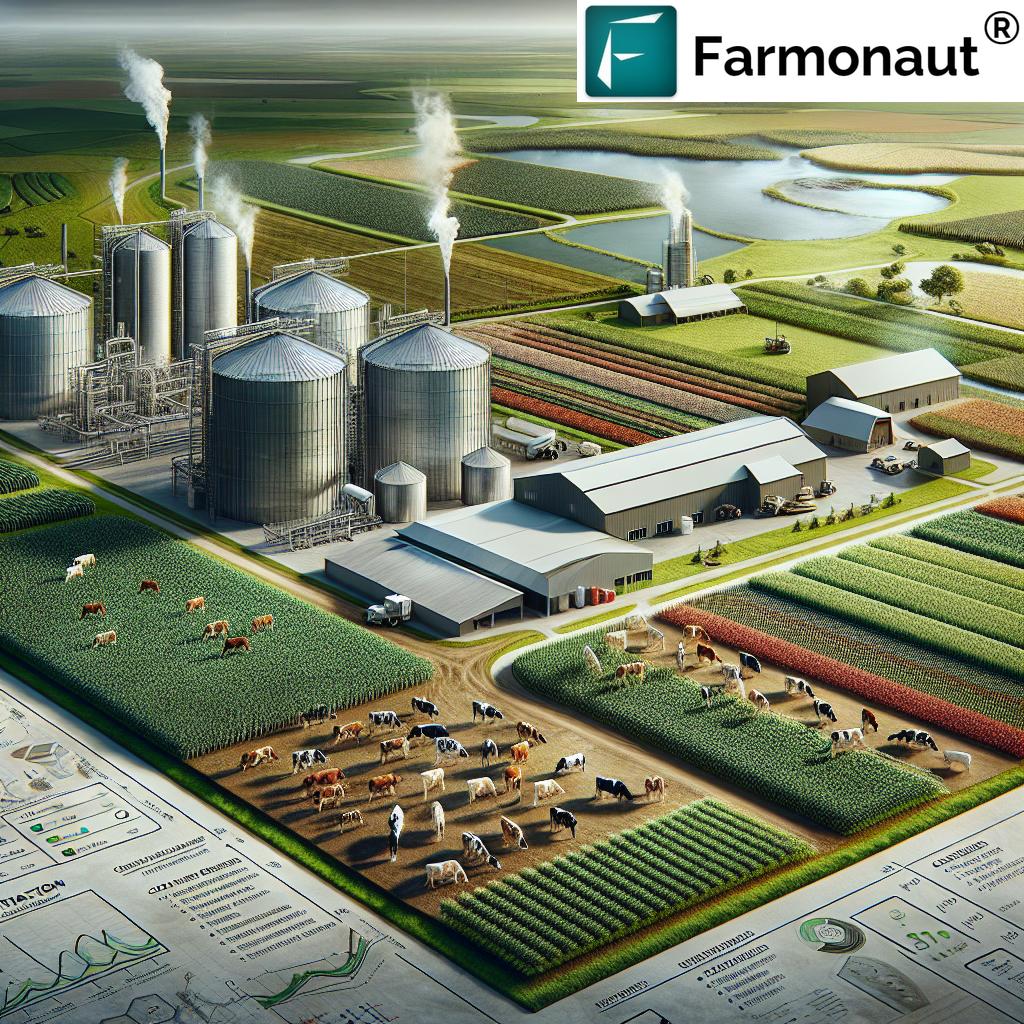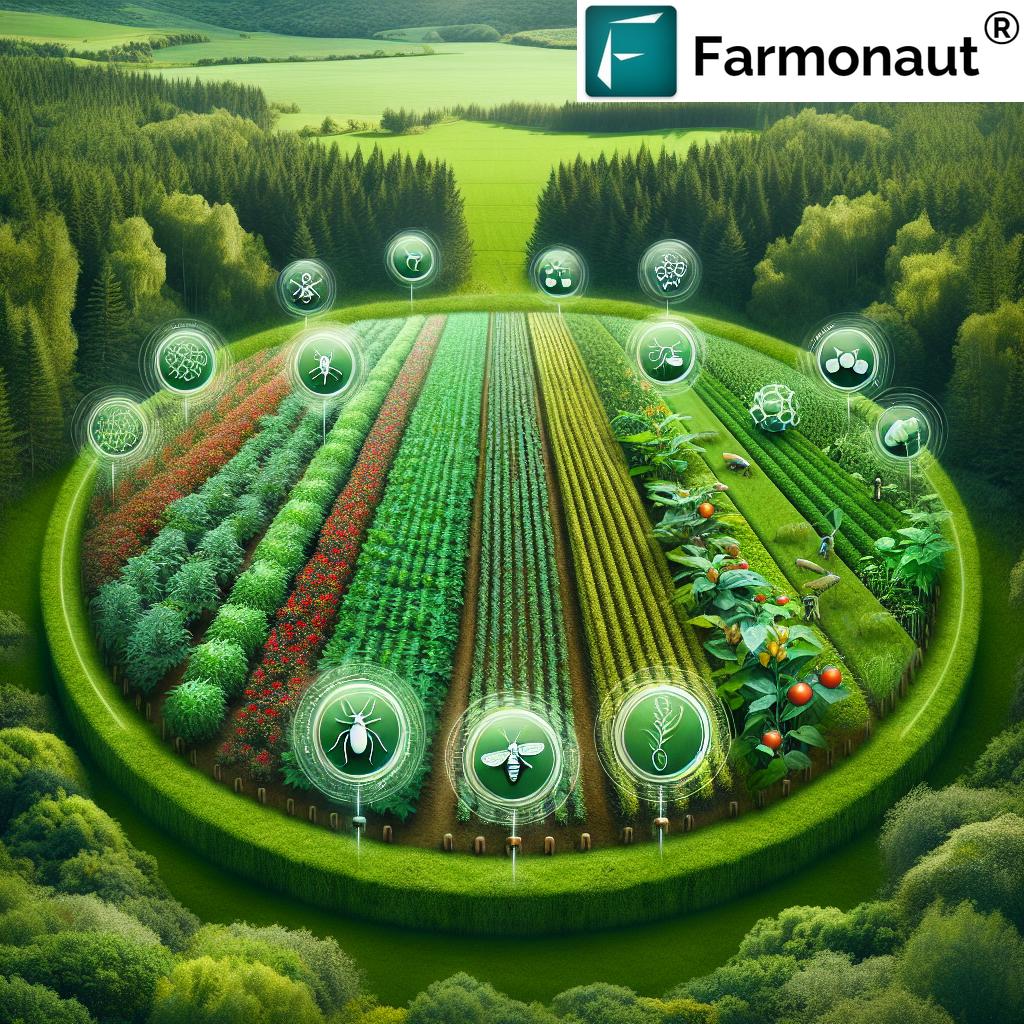Stages of Wheat Growth: Essential Steps to Maximize Yield
“Wheat reaches its critical flowering stage around 60-70 days after sowing, directly impacting final grain yield.”
Table of Contents
- Wheat Growth Stages Overview Table
- Introduction: The Importance of Understanding Wheat Growth
- 1. Germination and Seedling Stage
- 2. Leaf Development Stage (Feekes 1.0–1.9)
- 3. Tillering Phase (Feekes 2.0–2.9)
- 4. Stem Elongation Stage (Feekes 6.0–6.9)
- 5. Booting Stage (Feekes 10.0–10.5)
- 6. Heading and Flowering (Feekes 10.5–10.5.3)
- 7. Grain Filling and Ripening (Feekes 11.0–11.4)
- 8. Maturity and Harvest
- Best Practices for Wheat Crop Management
- Precision Wheat Management with Farmonaut
- FAQ: Wheat Growth Stages & Management
- Conclusion: Optimize Every Stage for Maximum Yield
Wheat Growth Stages Overview Table
| Growth Stage | Estimated Duration (Days) | Key Characteristics | Optimal Management Practices | Common Challenges / Remedies | Target Yield Impact (%) |
|---|---|---|---|---|---|
| Germination & Seedling | 7–10 | Radicle/root and coleoptile emerge; seedling arises above soil. | Ensure adequate soil moisture, optimal temperature (12–25°C), quality seed selection, manage seed rate, depth. | Poor emergence from deep planting, cold or dry soil—use certified seed and correct sowing depth. | 10 |
| Leaf Development (Feekes 1.0–1.9) | 10–14 | First through subsequent leaves unfold sequentially; canopy forms. | Monitor emergence, early irrigation if needed, initial pest control, balanced starter fertilizer. | Leaf diseases, early weeds—scout regularly, enable healthy canopy. | 7 |
| Tillering (Feekes 2.0–2.9) | 14–20 | Side shoots/tillers develop, increasing productive heads. | Apply nitrogen; maintain sufficient stand; manage weeds for full tiller development. | Low tiller number from poor nutrients or density; adjust fertilizer. | 20 |
| Stem Elongation (Feekes 6.0–6.9) | 10–15 | Stem internodes elongate; first node visible; rapid vertical growth. | Split nitrogen application; intensive irrigation; protect from lodging. | Nutrient deficiency, lodging—apply split N, monitor water balance. | 18 |
| Booting (Feekes 10.0–10.5) | 8–10 | Head enclosed in flag leaf sheath; visible swelling. | Scout for pests, apply fungicides if necessary, ensure optimal water/nutrient supply. | Head blight, late disease—timely fungicide, pest control. | 15 |
| Heading & Flowering (Feekes 10.5–10.5.3) | 4–7 | Head emerges, anthesis/pollination occurs, fertile florets set. | Avoid stress (heat/drought), manage pests, ensure moisture for good pollination. | Sterility from stress—irrigate, disease monitoring, prevent foliar diseases. | 20 |
| Grain Filling & Ripening (Feekes 11.0–11.4) | 20–30 | Kernels accumulate starch; transition from milky to hard dough to full maturity. | Maintain adequate water; monitor diseases; stop irrigation 2 weeks before harvesting. | Shrivelled grain from drought; ensure last irrigations; avoid premature senescence. | 10 |
| Maturity & Harvest | ~7 | Plant senesces, leaves/stems dry, grain at harvest moisture (13–15%). | Timely harvest, monitor for pests, weather-proof storage. | Overripeness/shattering; pre-harvest sprouting—monitor forecast, timely combine harvest. | — |
Introduction: The Importance of Understanding Wheat Growth Stages
Wheat cultivation is a complex process divided into several distinct wheat growth stages, each playing a critical role in the successful development of a healthy and productive crop. Understanding how the wheat plant progresses—from germination to maturity—enables farmers to implement effective management practices, optimize yields, and ensure high-quality harvests.
During this journey, both environmental and management factors—like soil moisture, nutrient availability, and temperature—directly impact key phases such as the wheat germination process, leaf development, tillering, grain filling, and final maturity. By recognizing when each stage occurs and what it requires, producers can target interventions to address specific crop needs, preventing losses and optimizing overall yield and quality.
As we examine the Feekes scale wheat and step through all phases of wheat plant development, you’ll gain practical, actionable insights for wheat crop management practices—ensuring your crops perform at their maximum potential, from the very first radicle to the final kill at harvest.
Tip: Use the Wheat Growth Stages Table and Table of Contents above to navigate quickly to the stage and management tips you need.
1. Germination and Seedling Stage: The Start of Wheat Plant Development
The wheat germination process begins when the seed absorbs adequate water from the soil, activating metabolic functions. Moisture softens the seed coat, leading to rapid intake and triggering the emergence of the radicle (the primary root) and the coleoptile (a protective sheath for the shoot). Under optimal wheat cultivation conditions—typically soil temperatures between 54°F and 77°F (12°C to 25°C)—germination and seedling emergence occur within seven days.
- Germination Triggers: Water uptake, temperature, and oxygen availability.
- Emergence Event: The coleoptile pushes through the soil, allowing the first leaf to emerge and begin photosynthesis.
- Nutrient Dependency: The seedling relies on energy and nutrients stored in the seed until leaves are functional for photosynthesis.
Management Tips:
- Ensure seedbed is firm yet friable for good contact and aeration.
- Provide adequate moisture, not excessive, to avoid seed rot.
- Use high-quality, disease-free seeds to prevent early losses.
- Avoid sowing too deep—this delays shoot emergence and depletes seed reserves.
Early success relies on monitoring these parameters, especially in variable environments. Satellite-based soil moisture monitoring—like that available via Farmonaut’s platforms—helps ensure optimal conditions are met from the start, preventing weak stands and low tiller potential.
For verifiable, quality seed sourcing and transparency in agribusiness supply chains, Farmonaut’s blockchain-based product traceability enables complete seed-to-harvest validation, helping both producers and buyers maintain confidence in input quality.
2. Leaf Development Stage: Establishing Photosynthetic Capacity (Feekes 1.0–1.9)
Following germination, the wheat plant moves into the leaf development phase. The first leaf emerges through the coleoptile (Feekes 1.0), followed by subsequent leaves unfolding sequentially (e.g., Feekes 1.1, 1.2…). Usually, a wheat plant will produce nine to fourteen main shoot leaves.
- Temperature Dependency: Leaf emergence rate is primarily controlled by temperature—warmer conditions accelerate development.
- Canopy Role: A robust canopy drives photosynthesis, influencing overall growth and preparation for successful tillering.
Management Practices During Leaf Stage:
- Quickly address weed growth to prevent competition for moisture and nutrients.
- Apply starter fertilizers high in phosphorus and micronutrients if soil is deficient.
- Use early irrigation judiciously to help roots penetrate; avoid waterlogging.
- Monitor for foliar diseases—young leaves are vulnerable to pathogens.
Effective leaf development lays the foundation for tillering, so it is critical to ensure each leaf is functional and the plant is not stressed during this phase.
“Proper nitrogen application at the tillering stage can boost wheat yields by up to 20%.”
3. Tillering Phase: Building Yield Potential (Feekes 2.0–2.9)
The wheat tillering phase (Feekes 2.0 to 2.9) is a critical stage for increasing yield potential. Here, the main shoot produces side shoots (tillers)—each capable of forming a grain-bearing head if properly nourished. Typically, tillering begins when the plant has three or four true leaves.
- Influencing Factors: Sowing density, nitrogen availability, soil moisture, and environmental conditions.
- Management for More Tillers: Sufficient nitrogen at this stage is vital. Farmonaut’s Jeevn AI advisory system recommends real-time fertilizer and irrigation strategies, helping farmers detect areas needing attention via satellite imagery (Web & Mobile App).
Management Practices:
- Apply top-dress nitrogen to encourage vigorous tiller development—especially in fields with good moisture.
- Keep weeds under close control, as tillers are highly sensitive to resource competition.
- Thin or uneven stands? Adjust by overseeding in future seasons, not during the current crop.
- Scout for both insect pests (e.g., aphids) and fungal diseases, applying protection if thresholds are reached.
Maximizing the number of productive tillers directly increases the final count of grain heads—one of the principal drivers of wheat yield. Effective tiller management during this period sets the stage for robust head formation and, ultimately, higher grain numbers.
Large commercial producers and agribusinesses can benefit from comprehensive field management using Farmonaut’s Large Scale Farm Management solutions. These tools streamline operations and support data-driven decision-making for multi-field tillering and canopy health analysis.
4. Stem Elongation Stage: Preparing for Reproduction (Feekes 6.0–6.9)
The stem elongation stage marks the transition from vegetative to reproductive growth in the wheat plant. Stem internodes elongate rapidly, with the first node becoming visible above the soil surface (Feekes 6.0). Subsequent nodes appear, and the developing head starts its upward journey within the stem, soon to be revealed.
- Rapid Growth: The growth point (meristem) moves above ground, making wheat sensitive to both frost and heat stress.
- Nutrient and Water Needs: The demand for nitrogen, phosphorus, potassium, and water peaks. This is critical for the formation of grain spikelets and florets.
Management Recommendations:
- Use split nitrogen applications: Apply up to 40–50% of total N at this stage for high-yielding crops.
- Maintain optimal soil moisture; irrigate if dry, but avoid waterlogging.
- Monitor for emergence of leaf/bacterial blight and manage if detected.
- Scout for lodging (plants falling over)—if crops are too lush or receive late N, use growth regulators if allowed by regional guidelines.
Leveraging real-time growth tracking and AI-based recommendations (e.g., via Farmonaut Jeevn AI) helps ensure the stem elongation phase proceeds under optimal conditions, maximizing the potential for strong, upright plants and uniform head development.
For those aiming to monitor and reduce environmental impacts during irrigation and fertilization, Farmonaut’s carbon footprinting tools provide real-time tracking, supporting compliance and sustainability in wheat production.
5. Booting Stage: Flag Leaf and Spike Development (Feekes 10.0–10.5)
The booting stage (Feekes 10.0–10.5) is identified by a pronounced swelling in the upper stem—the developing wheat head is enclosed inside the sheath of the flag leaf. This is a critical period for determining the eventual number of grains per head, as florets (potential kernels) are being fully developed.
- Visual Indicator: The sheath appears swollen; carefully opening it reveals the developed head.
- Management Focus: Monitor for pests (e.g., wheat stem sawfly), diseases (especially fungal head blight), and maintain sufficient nutrients and water.
Best Practices During Booting:
- Apply a final protective fungicide if disease risk is elevated.
- Avoid stress—any drought, heat, or chemical injury can lower floret fertility.
- Scout intensely for signs of stem boring insects or emerging fungal infections.
- Do not apply late nitrogen, as this may encourage too much vegetative growth and risk lodging.
Farmonaut offers automated flag leaf detection in satellite images, allowing users to quickly gauge if their fields are at the booting stage and assess for uniformity, planning timely pesticide and fungicide actions.
6. Heading and Flowering Stage: Pollination & Grain Number Set (Feekes 10.5–10.5.3)
Heading (Feekes 10.5) marks the emergence of the wheat head from the flag leaf sheath, followed closely by flowering (anthesis), usually within 4–5 days. This phase is vital because wheat is self-pollinating, with fertile florets being pollinated as anthers emerge, thus setting the final potential number of kernels per head.
- Environmental Sensitivity: High temperatures and drought at this stage can lead to sterile florets or poor kernel development.
- Optimal Management: Irrigate to avoid drought stress, control foliar and head diseases (especially Fusarium head blight) and ensure no foliar nutrient deficiencies.
- Pollination Risk: Rain or extreme heat at flowering reduces pollen viability and final kernel counts.
Crop Management Reminders During Heading/Flowering:
- Stop spraying most chemicals at this stage, unless absolutely necessary and permitted, to prevent disrupting pollination.
- Keep scouting for foliar and head diseases, acting fast if detected.
Use Farmonaut’s satellite-based crop health indices (NDVI) to identify stress zones within fields—enabling targeted irrigation or foliar sprays where needed to safeguard pollination and protect overall yield.
For direct integration of field monitoring and localized weather forecasting into your agtech tools, developers can leverage our powerful Farmonaut Satellite & Weather API. Full documentation: API Developer Docs.
7. Grain Filling and Ripening: Building Quality and Weight (Feekes 11.0–11.4)
The grain filling stage in wheat (Feekes 11.0–11.4) is the last leg of grain formation. Kernels accumulate starch and protein, increasing in size and weight over 20–30 days, depending on variety and weather. The process passes through “milky ripe” (Feekes 11.1), “mealy ripe” (11.2), then “hard dough” (11.3) before reaching harvest readiness (11.4).
- Compliance with optimal moisture: Maintain soil moisture until hard dough stage, then stop irrigation to allow drying.
- Kernel Quality: Environmental stress (drought, hot wind, premature nutrient deficiency) leads to “shrunken” or low-protein kernels, reducing grain quality and yield.
Grain Filling Management for High Yield and Quality:
- Continue disease and pest monitoring throughout, especially for head blight or sap-sucking insects.
- Cease irrigation 10–14 days before anticipated harvest to avoid high moisture content and sprouting.
- Senescence (natural drying) should be uniform; if not, targeted interventions may be needed.
Tracking canopy moisture status and field variability can be achieved with Farmonaut’s crop monitoring app—highlighting areas at risk of poor filling or early senescence.
For growers seeking crop loan or insurance validation, Farmonaut offers satellite-based, reliable farm verification, ensuring access to financing and reducing the risk of insurance fraud.
8. Maturity and Harvest: The Final Step for Yield Realization
Once the wheat plant reaches physiological maturity, its kernels are fully developed and dry. Leaves, stems and heads lose their green color as nutrients are remobilized into the grain and the whole crop dries down—this is the signal for harvesting.
- Moisture Content: Optimal harvest time is when grain moisture reaches 13–15%—lower values (<13%) can result in shattering, while higher values (>15%) risk spoilage and storage losses.
- Harvest Timeliness: Delayed harvesting leads to shattering, sprouting, weather damage, and low grain quality. Aim for a uniform and timely harvest.
Best Practices for Wheat Maturity and Harvest Timing:
- Test field sections with a moisture meter before harvesting.
- Adjust combine harvester settings to minimize grain loss and maximize efficiency.
- If weather is an issue (rain, hail forecast), harvest as soon as possible, even at slightly higher moisture, and use drying facilities if needed.
- After harvest, store grains in dry, pest-proof bins or bags; monitor for insects and fungal growth.
Best Practices for Wheat Crop Management at Each Stage
Success in wheat cultivation is built upon timely interventions at every critical stage of the plant’s development. Below, find a concise summary of wheat crop management practices across key wheat growth stages:
- Germination-Seedling: Ensure uniform emergence, manage soil moisture, avoid crusting and compaction.
- Leaf Development: Engage in rapid weed control and starter fertilization.
- Tillering: Apply nitrogen judiciously, maintain stand density, and monitor for early pests.
- Stem Elongation: Follow split N management, protect from lodging.
- Booting: Closely scout for disease; maintain optimal supply of water and nutrients for floret fertility.
- Heading/Flowering: Prevent environmental stress, protect against foliar/head blight diseases.
- Grain Filling: Keep moisture consistent up to the hard dough stage.
- Maturity/Harvest: Monitor grain moisture and conduct timely, efficient harvesting to lock in yield and quality.
Precision Wheat Management: Enhancing Every Growth Stage with Farmonaut
At Farmonaut, our mission is to revolutionize how wheat crop management practices are executed. By blending satellite imagery, AI-driven advisory, and blockchain traceability, we empower wheat growers worldwide to make data-driven, effective decisions throughout every wheat growth stage.
- Satellite Monitoring: Receive real-time data on crop health, soil moisture, and developmental stage mapping, aligned with the Feekes scale wheat framework.
- AI Advisory (Jeevn): Get instant, personalized crop management advice—whether you need nitrogen recommendations during tillering, irrigation alerts, or harvesting readiness forecasts.
- Traceability Tools: Maintain transparent, secure supply chains from seed to grain via blockchain-based product traceability.
- Resource Management: Coordinate field operations, logistics, and large-scale field analysis for multi-hectare or corporate producers with our fleet and resource management apps.
- Sustainability: Track environmental performance, carbon emissions, and compliance through real-time carbon footprinting.
With our affordable, scalable platforms on Android, iOS, and web, we make advanced wheat crop management accessible to individual farmers, agribusinesses, and agri-researchers globally.
Frequently Asked Questions: Wheat Growth Stages & Management
What is the Feekes scale and why is it important for wheat crop management?
The Feekes scale is a standardized method that divides wheat development into numbered growth stages, from seedling emergence to harvest. It enables farmers and agronomists to accurately time interventions—like fertilization, irrigation, and pesticide application—improving management and ultimately, yields and grain quality.
How do optimal wheat cultivation conditions impact yield?
Optimal cultivation conditions—correct soil moisture, temperature, nutrient supply, and pest/disease management—ensure every wheat growth stage proceeds without stress. Interruptions (e.g., drought at flowering or nutrient deficiency at tillering) can reduce tillering, kernel set, and final grain weight, lowering yield and profit.
When does the grain filling stage in wheat occur, and how long does it last?
The grain filling stage occurs after flowering/anthesis and usually lasts 20–30 days, during which kernels accumulate starch and protein until the crop reaches physiological maturity.
Can poor management during early stages be corrected later in the season?
Early-stage mistakes (e.g., low plant population, poor tillering) are difficult to fully recover from. Some compensation is possible with optimal management later (e.g., boosting N during stem elongation), but the potential for yield loss remains high. Prioritizing every stage is key to maximizing wheat yields.
What Farmonaut services help at each wheat growth stage?
- Emergence/Seedling: Satellite soil moisture and stand analysis via app.
- Tillering: AI-driven fertilizer recommendations and vegetation health mapping.
- Elongation/Booting: Growth staging, stress zone monitoring, disease risk alerts.
- Grain Filling: NDVI and moisture mapping, harvest timing forecasts.
- Harvest: Field harvesting operation management and post-harvest condition alerts.
Visit Farmonaut’s app for step-by-step guidance across all wheat growth stages.
Does Farmonaut support API integrations for agtech platforms?
Yes, developers and agtech companies can access satellite and weather data via the Farmonaut API. View full technical docs: here.
Conclusion: Optimize Every Wheat Growth Stage for Superior Yield & Quality
Every stage in the wheat plant development process presents unique challenges and opportunities for management. By understanding and actively monitoring the distinct wheat growth stages, farmers are empowered to implement targeted, effective practices—from the wheat germination process to tillering stage, grain filling stage in wheat and finally, timely wheat maturity and harvest timing.
Investing time in wheat crop management practices at each stage pays off through optimized yields, improved grain quality, and better resource use. As agriculture becomes more data-driven, technology platforms like Farmonaut can guide every decision, enabling both smallholder and large-scale producers to succeed sustainably.





















